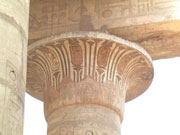TOUR NEWS - MALTA & SICILY - MAY 2016
The B.C. Archaeology Travel Study Tour of Malta and Sicily took place from the 7th to 28th May 2016. The group included Patricia Pemberton, Sandra Bardsley, Betty Elphinstone, Margaret Weissman, Judy Butlin, Robert and Robin Callister, and Kerry and Janet Peadon. The group was led by Michael Birrell (the author) and we were joined by Elizabeth Aquilina, our wonderful Maltese guide who treated us so warmly and imparted so much information about local customs and modern history. I came a few days early as did some of the others. The last members of our group arrived Sunday 8th May in the afternoon. I met them at the airport - once they were checked into our hotel we all went for a walk down to the harbour where there is a great view of medieval Valletta. We had some supper near the water.
We began our tour of Malta and Sicily on Monday 9th May. We went to the southern part of Malta to explore an ancient cave called Ghar Dalam which has evidence of Pleistocene life. We had a coffee at Marsaxlokk Bay then saw the Neolithic temples at Hagar Qim and Mnadjra. Built around 3200 BC they are remarkable structures built of colossal stones. In the afternoon we had a cruise around Grand Harbour in Valletta - this enabled us to explore the stunning fortification of the Knights Hospitaller, erected in the early 16th Century to guard against Ottoman encroachment.
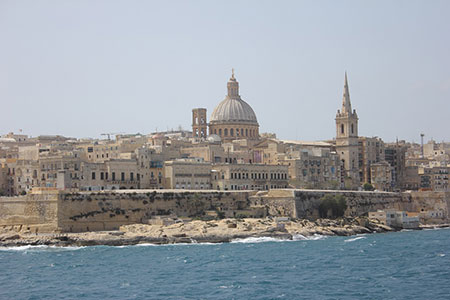 |
 |
The walls of Valletta |
The Neolithic Temple at Mnadjra |
The next day I took the group to see the southern and central part of Malta. We drove to the Dingli Cliffs (the highest point on Malta) and saw the ancient cart ruts nearby (probably dated to the early Iron Age). We then went to the ancient walled city of Rabat where we explored the Roman catacombs - the authorities have done a lot of work on improving access to the tombs. After lunch we visited the Roman House Museum which is built on the ruins of an ancient villa and preserves a group of mosaics, and then explored the medieval and Renaissance town of Mdina. We were invited to have dinner with our guide Liz and her family in the evening. What was meant to be 'nibbles' turned into a mighty and wonderful feast!
 |
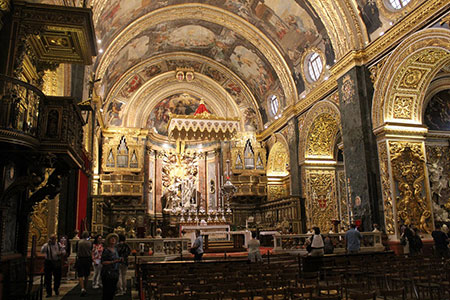 |
The medieval walls of Mdina |
The Knights Cathedral |
On the 11th May there was a sirocco (a hot dust carrying wind from North Africa) making the air hazy across all of Malta. We visited the island of Gozo which lies to the west of the main island. We caught the ferry and then toured the island. We saw the impressive Neolithic Temple at Ggantija, saw where Odysseus was supposedly bewitched by Calypso, and then drove down to the coast to see the cliffs. We had some lunch in Rabat and explored the impressive Citadel which was built by the Knights Hospitaller. The next day we toured Valletta, the capital of Malta. In the morning we visited the peninsula of Senglea to see the wonderful view across Grand Harbour. We then saw the Hypogeum (an ancient tomb complex) and the temples at Tarxien which were built 3600-2500 BC. After lunch in Valletta, we saw the Magisterial Palace of the Knights Hospitaller and the Knights armoury, and then the Cathedral of St John which was built in the late 16th Century. It is a remarkable example of the Baroque.
On Friday 13th we spent our last day in Valletta - we saw the archaeological Museum in the morning and then there was some free time - some of us went to see the Casa Rocca Piccola which is a beautiful 16th Century house still occupied by a noble family. I later went to see the Fine Art Museum which has a collection which includes a Turner. In the evening we flew to Catania in Sicily and met our driver Gaetano who drove the short distance to Syracuse. The following day was spent in Syracuse. In the morning we went to the island of Ortygia which is a very beautiful ancient and medieval quarter of the city. We saw the archaic Temple of Apollo and the Cathedral of Syracuse - this was once the Classical Temple of Athena and still preserves the ancient columns. It was very pleasant to have a coffee and ice cream near the famous Arethusa Spring. We also saw the archaeology museum and explored the antiquities in the archaeology park which includes a theatre and amphitheatre.
We had a scheduled free day on the 15th May and everyone did their own thing. A few of us went to visit the ruins of the Roman Villa del Tellaro near Syracuse which has a famous mosaic scene of hunting. When we got back some of us went to the Archaeology Museum for a second look. In the evening four of us went to see Sophocles' play Electra which was performed in the ancient theatre - this was truly amazing. It was performed at sunset and the performance was electrifying, very dramatic and physical with excellent acting and music effects.
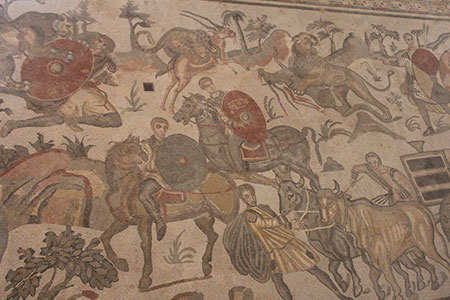 |
 |
Stunning Roman mosaics in Piazza Armerina |
Mt Etna smokes |
The next morning, we left Syracuse and headed north, stopping to see the early Iron Age tombs at Pantalica - I had not seen this site before so I was interested to see what it was like. It was a beautiful sunny day and we walked along the gorge where hundreds of tombs are carved. There was a good view of Mt Etna as we drove northwards. We then headed to the ruins of the Hellenistic city of Morgantina (3rd Century BC). We had a picnic lunch near the site, explored the ruins and then saw the museum at nearby Aidone which has some of the beautiful sculpture from Morgantina including archaic statues of the goddesses Demeter and Kore. In the afternoon we saw the stunning Roman mosaics at the Villa Romana del Casale near Piazza Armerina - they cover more than 4000 square metres and consist of an estimated 200 million tesserae (stone pieces). The villa probably belonged to an imperial owner of the 3rd-4th Century AD (Emperor Maximian or Maxentius?). There is nowhere even remotely like it.
On the 17th May we visited the medieval hill town of Enna in the centre of Sicily. We had a great view from the isolated rock at the east end of town where there was once a temple of Demeter - Mt Etna could be seen steaming in the distance. We explored the 13th Century Castello and had a wander in the town where we had a coffee and visited the Cathedral (dated early 14th Century). We also saw the bloody tower of Frederick II which was part of a hunting lodge. In the afternoon, after lunch, we drove down to the coast. We spent the following day walking around the ancient site of Agrigento, which lies near the south coast of Sicily. The city has some amazing Classical Greek temples which mainly date from the 5th Century BC and an excellent site museum with artefacts from the area. We had lunch down by the seaside. The next morning we headed west along the southern coast of Sicily. It was a bit cloudy but not cold. We spent the day at the ancient site of Selinunte where we explored the Classical temples and saw the recently restored bronze statue from the site. In the afternoon we drove to Marsala where we checked into the hotel.
The next day we visited the beautiful island of Motya which lies near Marsala in western Sicily. We visited the site museum which is in the old house of Joseph Whitaker, an Englishman who exported marsala style wine to the UK in the early 20th Century and who did amateur excavations in his spare time (it would be nice to own an island with an ancient Phoenician settlement on it!). We explored the island and saw the Phoenician remains. When we returned to the shore we had a very pleasant seafood lunch near the old windmills - I shared a huge fish mezza with all sorts of cured and smoked fish and octopus. We returned to Marsala and saw the ancient Roman ruins which included a villa with mosaics.
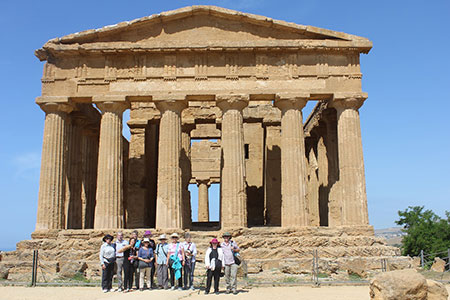 |
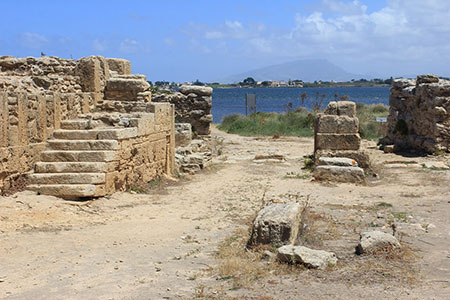 |
The group at Agrigento |
Exploring Phoenician remains on Motya Island |
On the 21st May we drove north to the hill town of Erice. It was an old Phoenician and Roman town but it is best known for its Norman castle. It was cold and misty for most of our visit but eventually the sun came out. In the afternoon we visited the ancient site of Segesta which has a wonderful 5th Century BC temple and a theatre with a magic view over the countryside. We drove along the coast on some amazing flyovers through very scenic country. We checked into our hotel in Palermo where we stayed for 3 nights.
The next day we explored some of Norman era Palermo. We started with a visit to the 12th Century Cathedral which has seen many changes over the centuries. We saw the tombs of the Norman Kings including Roger II and his daughter Constance, and her husband Emperor Fredrick II. After a much needed coffee we went to see the Norman Palace - the 12th Century Palatine Chapel of Roger II and William I is superb and we spent a long time looking at the gold mosaics of the walls, and the amazing painted wooden ceiling with Arabic style paintings. We also saw the royal apartments of the Norman kings, mainly decorated by King William I. We had some lunch and then went to the Palermo Archaeological Museum. This has been closed for a few years for a major refit but they had recently opened a small part of the collection to the public. The Museum is in a wonderful palazzo with garden courtyards.
The next day we went into the hills behind Palermo to see the 12th Century Norman Cathedral at Monreale which was built by King William II. It is an amazing building and beautifully restored - it has 6000 square metres of mosaics using about 2.2 tons of gold leaf. The cloister of the Benedictine monastery is decorated with fascinating Romanesque capitals showing mythological subjects. We then came back to Palermo to see the 12th Century Zisa Palace, a private retreat in the countryside for Norman King William I - it houses beautiful treasures from the Islamic Period. Gaetano took us for lunch down by the seaside at the Palermo suburb of Mondello � this is a stunningly beautiful place. We returned to town and saw the 12th Century Norman churches known as the Martorama and San Cataldo - we also stopped to explore the Capuchin catacombs with their amazing mummified remains from the 16th to 19th Century.
On the 24th May we left Palermo on the north coast of Sicily and drove eastwards to the ancient Punic and Roman site of Solunto. We visited the ruins of this ancient town which lies on a spectacular peninsula jutting out into the Mediterranean Sea. The small museum has some nice objects including statues and Roman glass objects. We had lunch down by the little harbour of Solunto and saw the fishermen selling their catch directly from the boat. From here we drove through the centre of the island to the eastern port city of Catania where we stayed 3 nights. We had a pleasant dinner in the old city a short walk from our hotel. The next morning we went to the top of the Mt Etna volcano (about 3000 m). Special buses took us up to the summit, while on the way down we experienced a somewhat nerve wracking cablecar trip (since it was quite windy). We saw lots of hot gases coming out of the summit caldera and could hear tremendous explosions from the main crater. We headed back to Catania where we had a late lunch. In the afternoon we saw the Castello Ursino which was built by Emperor Frederick II in the early 14th Century.
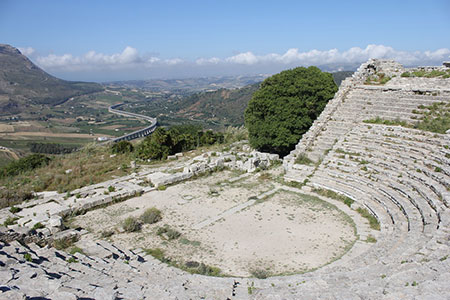 |
 |
The theatre at Segesta |
The stunning Palatine Chapel in Palermo |
The last morning of the Malta Sicily tour was spent exploring the old quarter of Catania. We went first to see the fish markets down near the harbour - there was an amazing range of fresh fish. We went inside the Cathedral and in the town saw a celebration of the police and emergency forces which was taking place in the square outside (which included police in fancy period uniforms!). We also went to see the ancient Greek and Roman theatre which has been excavated out from underneath the medieval quarter. In the afternoon we drove north along the coast from Catania to Taormina. This was an ancient Greek colony which was taken over by the Romans, later ruled by the Arabs and Normans. We explored the ancient Roman theatre of Taormina which has stunning views towards Mt Etna. We had some free time to explore Taormina and do last minute shopping. That night was our last in Sicily and we had a pleasant meal near our hotel in Catania. My thanks to Liz for all her efforts and for Gaetano for his remarkable driving skills.
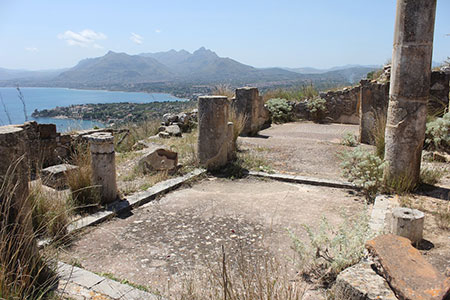 |
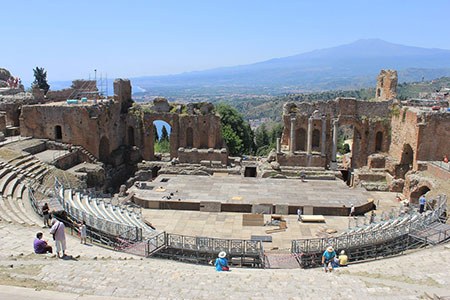 |
The Roman ruins of Solunto |
The famous theatre at Taormina |
Michael Birrell
